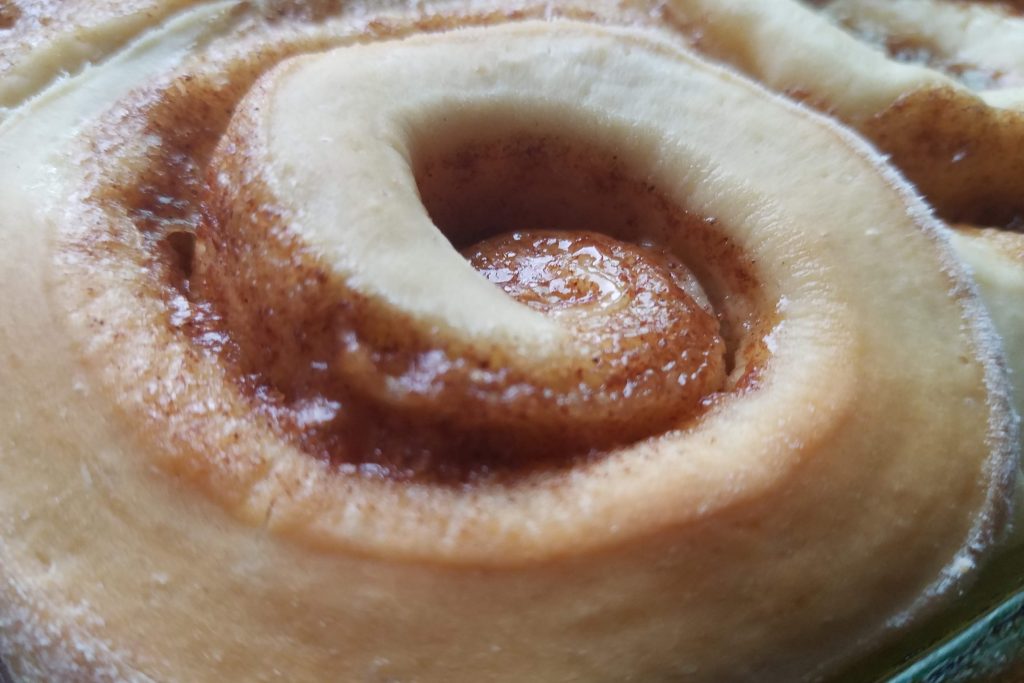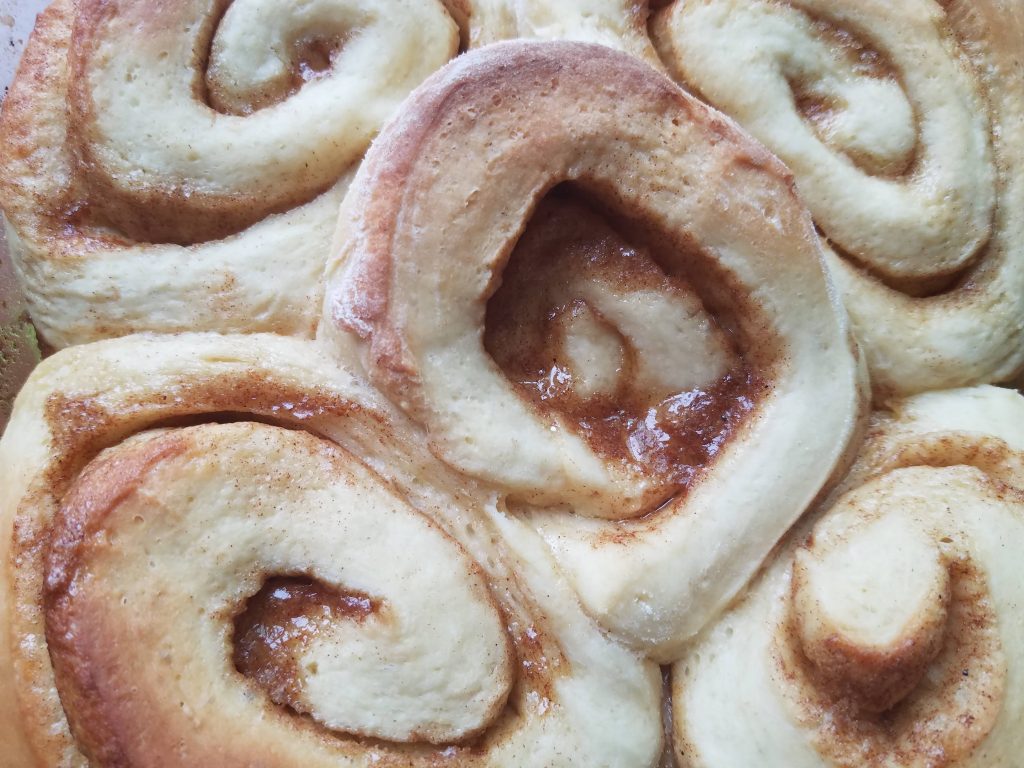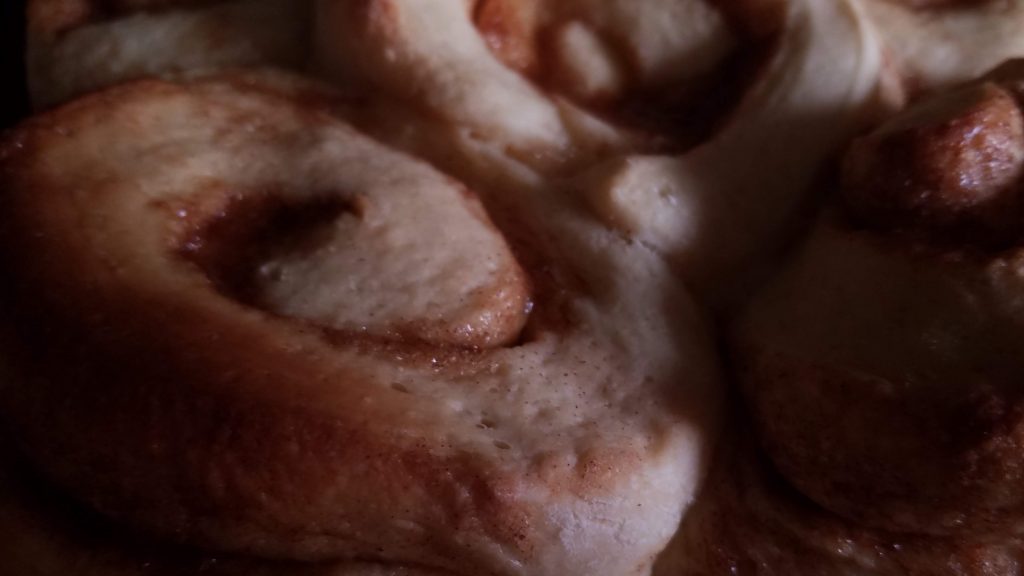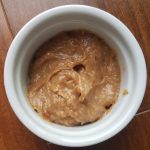Recipe for Overnight Cinnamon Rolls
Overnight cinnamon rolls are a phenomenal way to start your day.

Overnight Cinnamon Rolls
Ingredients
Dough
- 1 cup milk
- 1.5 tbsp dry active yeast
- .5 cups sugar
- 6 tbsp unsalted butter (softened)
- 2 eggs (room temp)
- .25 cups sourdough starter (optional)
- 1 tbsp vanilla
- 4.5 cups flour (use about 4-4.25 cups if not using starter)
Filling
- 6 tbsp unsalted butter (melted)
- 1 tbsp cinnamon
- 1 tsp nutmeg
- 1/2 cup sugar
- 1/3 cup brown sugar
Instructions
- Make sure you have enough room in your refrigerator for this recipe to safely sit overnight
Dough
- Bring milk to about 110°F using a saucepan or your microwave
- Add milk and yeast to a large mixing bowl and let rest until foamy (about 5 minutes)
- Add all dough ingredients, apart from flour, into the bowl and mix.* Add in 4 cups of flour and mix thoroughly. This requires a sturdy spoon and some hand kneading, or alternatively, a dough attachment on a stand mixer (so I've heard). Add the remaining flour (and perhaps a bit more) until your dough is smooth and no longer sticky.*If you have a sourdough starter discard, you can add about 1/4 of a cup to this. If you don't have a starter, that's fine. Just reduce the flour by 1/4 of a cup.
- Let the dough rest covered for 1-3 hours, or until doubled in size
Filling
- Combine filling ingredients in a medium bowl
- Prep a 9 x 13 baking pan with nonstick spray (if you, like me, don't have one this large, use two 8 x 8 pans)
- Place risen dough onto a floured surface and flatten/roll into a rectangle with a height of 1 cm to .5 inches using a rolling pin (thinner dough will make a tighter spiral, a thicker dough will have a doughier spiral)
- Brush filling across the rectangle
- Roll rectangle from the long side to make a long cylinder/log
- With the seam side down, use a sharp knife to slice to log at 1 inch or 2.5 cm intervals
- Place the rolls into the baking dishes, cover and refrigerate overnight (8-10 hours)If this was too much effort without nearly immediate gratification, you can skip this step (note there's still 2 hours before they'll be ready)
Morning Of Instructions
- Allow the dough to rise at room temperature for an hour to an hour and a half
- Preheat oven to 375°F
- Cook the buns for at least 20 minutes, checking centers to see if they're cooked through
- Remove from oven and let cool for about 8-10 minutes
- I like to eat these without, but feel free to ice them will vanilla frosting or make a cream cheese icing

Baker’s Notes for Overnight Cinnamon Rolls
Why an overnight recipe? Because waiting 1.5 hours before cooking is far more manageable than 3 hours, plus the prep and mess before 9 AM. But by all means, morning people, tackle the whole thing starting at 6 AM.
How does this work overnight or in succession? Placing yeast or dough with yeast into cool temperatures causes the yeast’s activity to slow, until the yeast is nearly dormant. This delays the rising process, allowing for slower fermentation and in some recipes, for a shift in flavor profile. In regards to this recipe for overnight cinnamon rolls, the delay is long enough for the kitchen to be cleaned and for a good night’s rest to be had.
More about the icing…. Most cinnamon roll enthusiasts enjoy the vanilla icing atop the rolls nearly as much as the pastry base. A personal fondness for the base flavors discourages me from topping my own serving with icing; however preparing a homemade cream cheese icing is a simple add-on.
This seems complicated. The first time, undoubtedly, yes. However, baked goods are rather forgiving if you keep an eye on them and are patient. Reading how a few people like to do a recipe, before making the first attempt is always a good idea. Once mastered (or attempted 2 to 3 times) this recipe feels natural. The appeal and satisfaction of making these opens doors to other fun baked goods, like biscuits, croissants, brioche, and monkey bread.
What does the added sourdough starter do? Nothing. Everything. It’s up to you.
- The starter is unnecessary.
So, nothing really. As advised in the recipe, the 1.5 tbsp of active dry yeast will do quite well on its own, you’ll just have to watch the quantity of flour you add. - It’s essentially bonus yeast.
Let a smidgen of wild yeast tackle the stuff from the store. One of them, at least, should survive. - If you have a starter already, why waste the discard?
Better yet, isn’t needing something to do with the discard, so as to not be wasteful, the most wonderful excuse to make cinnamon rolls. - It’s an easy experiment.
As you begin to add starter to different recipes, you learn how to use it. Technically, since the starter is equal parts flour and water, you can use it to substitute for the equivalent amount of liquid and flour in most rising dough baking recipes. In this recipe, it added a bit of “liquid” which is why I make the note to use a touch less flour (which is affected by the air temperature and water content of your household as well).
Why make cinnamon rolls from scratch? The texture. The sense of pride and accomplishment. The ability to customize or add additional flavors and spices. Generally, flavor excellence.
Homemade, As Opposed to Canned
Canned cinnamon rolls are easy. The can gets popped open, the rolls are split from the log, and into the oven they go. It’s fast. There’s very little preparation or cleanup. It also has a peculiar taste.
Homemade cinnamon rolls are superior to the canned variety; namely, because the odd “canned biscuit” taste does not linger in your mouth, destroying the impact of the sweetened roll.
Canned biscuits, cinnamon rolls, and dough tend to have added chemicals and an inordinate over saturation of something reminiscent of the taste of accidentally tripling the baking powder needed in a recipe. The taste is perfectly acceptable for the average person, until is noticed. Then, one cannot help but notice. In some recipes, it’s not too terrible, especially in those recipes that use savory spices and richer flavors. It can honestly work to the favor of some biscuit recipes.
It is not so with cinnamon rolls. The lightness of the flavors in cinnamon rolls, the fragrance from the vanilla, sugars, and cinnamon, are overwhelmed.

Useful Recipe Links
Where to Venture Next
Cinnamon rolls are a baking gateway; once mastered, other recipes are far less daunting. The end result is fun and the process forgiving enough that it’s encouraging. Children (and anyone else in your household) will not object to involved experiments in the kitchen if the result is a breakfast pastry.
As mentioned above, recipes like croissants, pie dough, and pumpkin rolls, are far more attainable. There are also intriguing experiments to be had with cinnamon rolls. Adding more spices. Pumpkin cinnamon rolls (not to be confused with a pumpkin roll or pumpkin rolls). Lemon-inspired dishes. Garlic-inspired dishes (because everything eventually leads to garlic).


1 thought on “Recipe for Overnight Cinnamon Rolls”